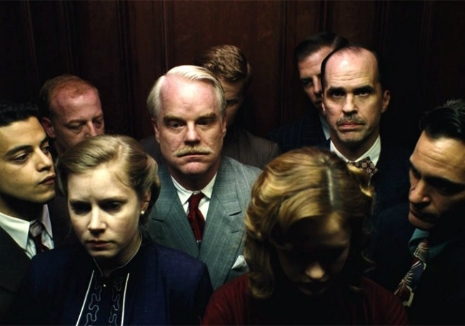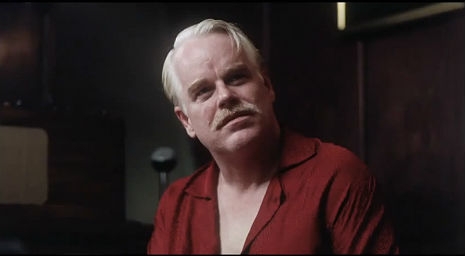
There are few theaters left in the world that have the capability to screen 70 millimeter film. Which is a shame. Because if you’re going to see Paul Thomas Anderson’s The Master one of the main reasons to do so is to be ravished by the look of the film, which was shot in the high resolution 70mm format. The Ritz (part of the Alamo Drafthouse chain) in Austin will be screening The Master in 70mm when the film opens wide on September 21. While Anderson has made a bold move by reviving the format, this isn’t a first for The Alamo. In its ongoing commitment to present films as they were originally shot, The Alamo has already been screening classics like West Side Story, Indiana Jones And The Last Crusade and Baraka in 70mm. Upcoming films include Ghostbusters, Cleopatra and Jacque Tati’s Playtime. Bliss for film fans
I saw The Master in 70mm this past Tuesday and it really is an amazing looking film. The opening shot of ocean water churning in the wake of a boat was the bluest blue I recall ever having seen projected onto the silver screen. A series of shots in a mid-twentieth century department store had the heightened look of photo realism, the colors so rich they seemed edible. Yes, the film is ravishing to look at, but as an emotional experience, it is hollow - an epic about nothing. It may be a masterpiece of some sort, but it’s not a good movie.
Anderson creates screenplays that on the surface seem important but as you attempt to dig deeper there’s nothing below. It’s like the wooden laminate flooring you buy at Home Depot - there’s a veneer of faux wood stamped onto some synthetic crap. It pleases the eye and fools you into thinking you’re seeing something real, but it’s plastic.
The Master approaches subjects that had they been examined with more insight and imagination could have yielded hugely thought-provoking and entertaining results. Subjects like Scientology, sexual dysfunction, post traumatic stress disorder, psychoanalysis, masculine rage, past life regression, alcoholism and the cult of personality are rich in possibilities for a director who might have a real passion for storytelling. Unfortunately, Anderson doesn’t seem to have either the patience, the intelligence or curiosity to approach these worlds with more than a glance. It is not enough to throw this stuff up on the screen and hope that somehow through some sort of mystic alchemy they will coalesce into something approximating a point of view - something that transcends mere technique and gives us something to think about, to feel. Not even Jonny Greenwood’s relentlessly melodramatic score can fill in the emotional blanks. Anderson’s eye candy may be gorgeous, but it has little nutritional value.
Frankly, I’m fucking tired of film makers who demand that their audiences fill in the blanks. There’s a mighty big difference between films that compel one to think and those that ask the viewer to co-write the script. Like the Rorschach test that appears early in the film, The Master asks us to make something out of a series of beautiful blots on the screen. When confronted with the Rorschach, the main character in the movie sees mostly “pussy.” When confronted with The Master I saw something other than “pussy.” But it wasn’t nearly as satisfying. And I saw it in 70mm.
The Master has two brilliant performances that will no doubt be nominated for this year’s Academy Awards. Joaquin Phoenix and Philip Seymour Hoffman are extraordinarily good in roles that have almost no anchor in character. These are indelible acting riffs that exist in a series of powerful moments none of which connect to the other. Therefore, they have no momentum or shape. As you watch Phoenix and Hoffman act, you’re enthralled not by the persons they’re depicting but by their skill in making you believe in something that is not there. I challenge anyone who sees the film to tell me who these men are…what makes them tick, why they do what they do. And most importantly: why are they drawn to each other? As much as I admire the acting skills on display here, there’s absolutely nothing to engage you. And that goes for the rest of the cast as well. These people are members of some kind of Scientology-like cult. Even cults built on depersonalization have some defining qualities. With the exception of one jarring scene involving a nude sing-a-long, there’s nothing about this group of people that differentiates them from any gathering of good friends. They could be your local PTA. Why make a bunch of boring stiffs the subject of a movie? Even the normally magnetic Laura Dern fails to make an impression.
Hoffman has a certain appealing bluster in his depiction of an L. Ron Hubbard-type guru. But he’s more of a mess than a messiah. It’s hard to believe that anyone would fall sway to this fleshy fellow with anger issues and an alcohol problem. He’s a huckster more along the lines of Criswell than Hubbard and I guess it makes some sort of sense that his most slavish disciple (Rivers) seems to have wandered in from a Jim Thompson novel.
Anderson has been given all kinds of props for being some kind of wunderkind, a boy genius film maker. Well, guess what? He’s no longer a boy. He’s 42 years old. One year older than Roman Polanski was when Polanski made a genuine masterpiece Chinatown. He’s seven years older than Donald Cammel was when Cammel made (with Nic Roeg) the mindbendingly brilliant Performance.
Anderson has formidable skills, but he lacks the ability to summon up a vision from deep within. No matter how hard his characters stomp their feet and no matter how many millimeters he has at his disposal, there is something emotionally stunted in his work. His films are beautiful, and like Stanley Kubrick’s they have their own special architecture. But just as Kubrick’s films suffer from a lack of a human pulse, so does Anderson’s. His movies feel as though they were made by someone who hasn’t really lived yet. Anderson’s ideas may appear big and gorgeous looking. But so is Italian pastry…and that shit’s mostly air.
I recently watched F.W. Murnau’s beautiful and moving Sunrise on my television set. In terms of scale, it was as far as one can get from seeing The Master in 70mm. Sunrise is black and white, silent and was made in 1927 when its director was 39 years old. But any given scene in Sunrise packs more of an emotional punch, a sense of humanity and an engagement with the world we live in than the entirety of The Master. Proving, at least for me, it’s not the size of your frame that matters, it’s what you put into into it. It ain’t the meter, it’s the motion.






